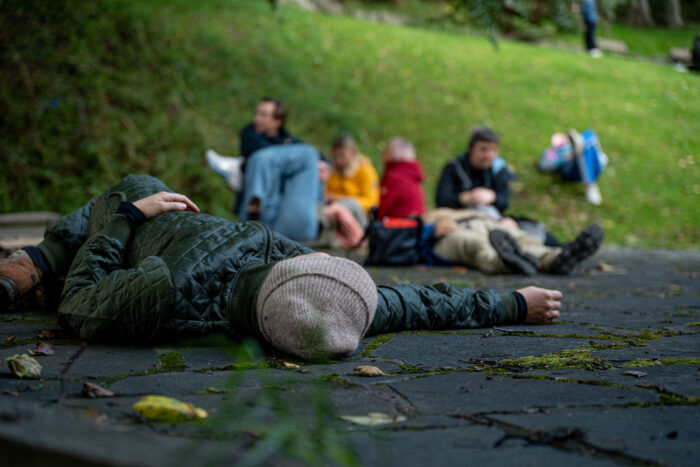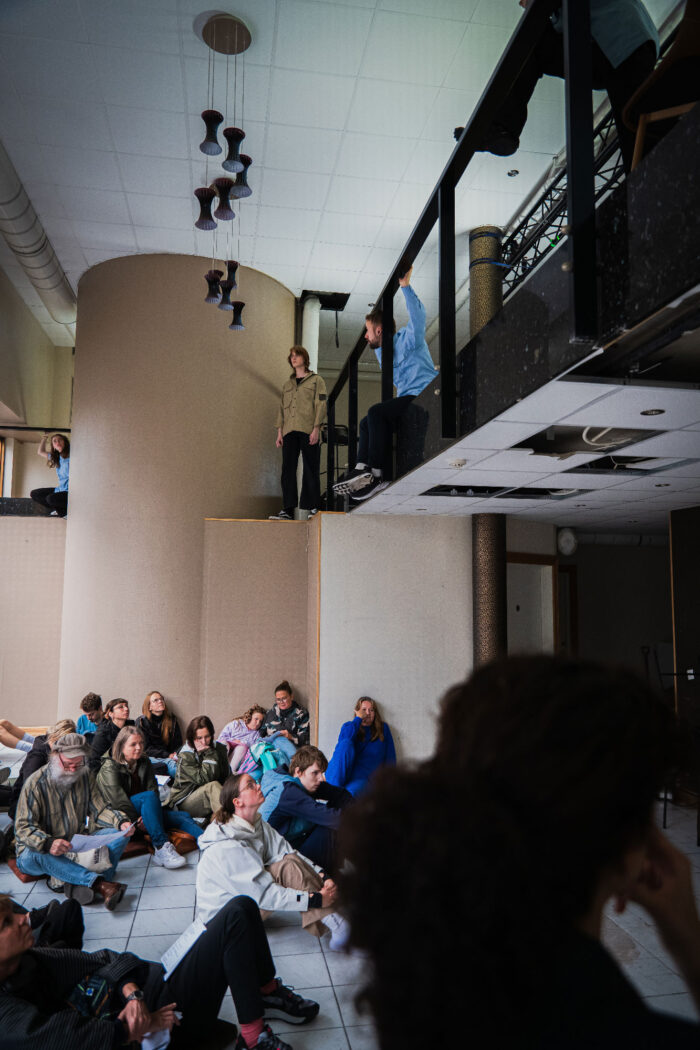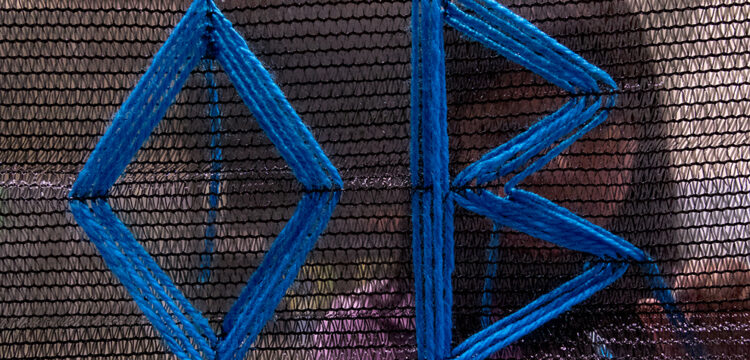Kisses from Ålesund
A festival of landscapes
Høstscena is a multidisciplinary festival, a celebration of all arts, a local and international contemporary cultural event, “a staged arts festivity” that happened at the end of September in Ålesund, Norway.
Even before I got there, to me Ålesund was a fact. I had numerous conversations with Høstscena Festival’s co-curator Lisa Gilardino, and heard many stories from some of the artists belonging to the Italian scene she had invited to participate. Last but not least, one of them, Muna Mussie, asked my help to translate some of the interviews that were one of the starting points of her work at the festival. Those words, those accents, those stories went through me and left vivid images. The plane that took me from Amsterdam to Ålesund landed with the sun. Later they told me I was lucky, as it’s not so common. While I was trying to stay awake to observe what was such an anomalous panorama to my eyes, I thought—rather than arriving, I feel like I’m returning.
A few days later I found in a book by Siri Hustvedt a sort of cataloging of memories. Starting from the assumption that we are all made of what we define as memory, “not only the bits and pieces of time visible to us in pictures that have hardened with our repeated stories, but also the memories we embodied and don’t understand (…). And then there are the memories of others that we adopt and catalogue with our own, sometimes confusing theirs with ours.” For me, this served as a guide to Ålesund, as I realized that meetings were what I was looking for, in verification or denial of what I had imagined.

The—very true—sentence I most often heard in interviews claimed that, in Ålesund, a day had all four seasons. Also other hang outs were mentioned, such as the Teatrenfabrikken, the floating sauna, and the pier. Upon my arrival, we had a walk to the lighthouse (which is no longer in use, and is now rented out for first wedding nights) to witness the dark sea speaking to a very large sky; then a visit to the suggested museums, a trip to a beach on a nearby island. I experienced my stay in Ålesund through the eyes and the guidance of people who have lived there for a long time, who taught me how to get into it. This emotional journey through the city created an immediate bond with those specific landscapes and places. This is a fundamental fact, intrinsically linked to what Høstscena has been.
Beginning from the end
As it often happens, the end of it all was a party, a rave in the garage of a shopping mall, in the center of Ålesund. A rave for disabled teenagers where we adults were just guests. A rave where we did karaoke, just danced, ate chips and used glitter make-up. A rave that isn’t over yet because before entering we were given a letter from a person who couldn’t be with us, signed as “a person on wheels”, who told us about her life. This letter kept working on us, as if it was another time. Festivals do work on rhizomatic temporalities, after all. What Mckenzie Wark calls the continuum, referring to rave time as “a time that exists outside of every other time.”
Both the letter and this party are part of a larger project brought to Høstscena by disabled artist, performer, and activist Chiara Bersani. A few days earlier we were in fact summoned to Atlanterhavsparken, Ålesund’s aquarium, a place where marine creatures of different species live in an environment in close contact with nature. Bersani performed her solo L’Animale (the animal) in front of the large fish tank, an actual encounter between the choreography created during pandemic times and the creatures inhabiting the aquarium. As Bersani writes “the meeting of solitudes, a meeting of monsters and mythologies.” The performer on a platform choreographs a dance of farewells, in the construction of an impossible monument which, in narrating loneliness, spans through the feeling of loss. Solitude becomes a choreography full of worlds and possibilities of a thinning line between the visible and the invisible, of an interaction between human and non-human. Rachel Carson talks about the ocean as a place of paradoxes, where the infinitely small and the infinitely large meet, where everything is made and guided by water. That’s how we felt, immersed in the ocean water, as if the glass wall of the tub was no longer there, as if time had stopped and the manta ray that lined up with Bersani’s dance was looking right at us, detecting something about that person we had soon to say goodbye to.
During this Festival, Bersani has repeatedly invoked the figure of the traveler, especially in one of the latest works presented at Høstscena, Cordata (cordate), delivered to us with one of the most important objects related to traveling: the postcard. Postcards with the greeting “Kisses from Ålesund” were scattered around the city, with a qr code behind linking to the Norwegian version of the work narrated by Jorunn Skjelten’s voice. Various spots in the city are signposted to follow the story of an imaginary landscape, shaped by all the places Chiara Bersani has encountered in her several trips to Ålesund, while she was making it “home”.

In Muna Mussie’s The Perfect Human From Sunrise to Sunset, the rope used in Alpine climbing—which in this case is a fishing line—becomes an entanglement. Muna Mussie takes inspiration from the film The Perfect Human by Danish director Jørgen Leth to create a long durational performance that intertwines several layers. In the background, a video projection shows images of a security room in the city of Ålesund, an urban x-ray that outlines the skeleton of the city. On stage Muna Mussie herself weaves a fishing net together with local performers Beatrice Tibavy, Josephine Sand and Chelsea Sand. Creatures dressed in black with braids embedded with beads and an animal tail seem to have emerged from an abyss of a parallel dimension. The materiality of the fishing net mixes with hairstyles of African heritage, in a mix of materials resulting from the artist and performer’s long research in the city of Ålesund. In the background, a symphony of voices, languages and accents shapes a sound score made up of interviews conducted by Muna Mussie with local people. A fresco, as a portrait that escapes the canonical narrative, recalls one of those great nineteenth-century paintings depicting Nordic mythology.
Instead, the teenagers taking part in Francesca Grilli’s Record choir are tied to safety ropes. A bitter descent into the bellies and minds of young high school students and their gaze to the world. Unanswered messages, chats that start and never end, to escape a reality you know is too harsh, where the risk is also to fall into the void. For this version of Record, Grilli and her working group invited a group of local teenagers. A dark fairy tale we watched from below with our necks upwards, as the performers sang on a mezzanine of a former shop in the center of Ålesund. This overturned perspective helped us to see something else: “On the ground floor a group of people is looking up where I am floating in the air and singing, everyone’s looking at me, people are listening to me.”

Entanglements
From the first moment, Høstscena presented itself to our eyes as a real entanglement. In its shared curatorship with Lisa Gilardino, Poka-yio and Helle Siljeholm, as well as the carte blanche for site-specific projects, director Siri Forberg’s curatorial approach gave life to an organic festival where the different curatorial practices that met generated something other. The different projects that inhabited Ålesund during Høstscena 2023 East of the Sun, West of the Moon (this was the title) were a mix of small festivals that flowed into each other, constellations of the very same galaxy which, despite their diversity in language, did not travel separately. Attending the festival as it unfolded meant taking part in something that on the one hand built a possible model for cultural policy, while on the other had the flavor of a transformation. Compared to past editions, this one initiated a gentle transition through an openness toward different types of languages.
Ivan Dujmusic, Rana Issa and Solveig Styve Holte inhabited the Mottaket i Nedre Strandgate and from there they expanded throughout the city in a totally non-linear movement. Open every day, the space hosted a library of texts relating to the theme of the body, on a large white panel the drawing mapping several locations in Ålesund chosen by the three artists to take a break. The author Rana Issa and the choreographer Solveig Styve Holte organized meetings open to the public, speaking of the body from various points of view. In the city one could come across the writing “The beauty of green lies in the fact that blue touches yellow”, which we also carried around on our bodies with a temporary tattoo, while Solveig Styve Holte was lying in some corners of Ålesund for her performance, a subtle invitation to rest in a continuous passage between outside and inside, in the spirit of Kvilande Levande. A phrase I read during the pre-opening struck me, because it sounded like a spell whose meaning I only discovered almost by the end of the festival: “resting alive”. It doesn’t matter if I didn’t immediately understand it, as surely my being lost in translation had an inestimable value. When I could not understand everything immediately, I’d let things work and at a certain point—even after some time—manifest themselves, or no. Therefore, I remain with the desire to have wanted to understand the story told by Rana Issa in her Radiorana. In fact, I know that happened anyway, somehow.

Landscapes
For me, Høstscena was a Festival that left space for the creation of landscapes. A space to stay, to rest at each location, to lie down on the sculptures/cushions of Greek artist Dora Economou, who created a refined work based on the dialogue between fabrics and patterns, as a result of her research in the city. We felt we had a space to be with other people, to get to know each other, to dialogue and come in contact with practices. A space that crosses through Ålesund, where we got to know a bit about that seaside town, invaded by cruise ships, almost completely rebuilt in Art Nouveau style after a fire in 1904, with the most beautiful antique shop I have ever seen, with windows at sea level and a sofa to drink a coffee on. Something not to be taken for granted in terms of artistic production was to understand what the passage of the artists of the Festival was like, their spending a long time in Ålesund at different times of the year is reflected in their works and research. How temporality is continuously unhinged of what is expected from a festival. This also gave me the possibility to pay attention to the non-human, as seen in Høstcena’s first film production of Thus waves comes in pairs by Lebanese film-maker Mira Adoumier.

In a place like Ålesund the landscape dominates the everyday life. Rain, wind, sea, stars are materials that play a fundamental role. The constant presence of nature, in her violent beauty and such an ancestral strength, one cannot help but be moved when standing in front of it. The radicality of this relationship with nature is the same I found in the festival: always being in the here and now, collectivizing a non-performative being, embracing the difficulties and the risk in the construction of a festival that is done together day by day, not as a format to consume but as to leave the window facing the landscape wide open to encounters.



